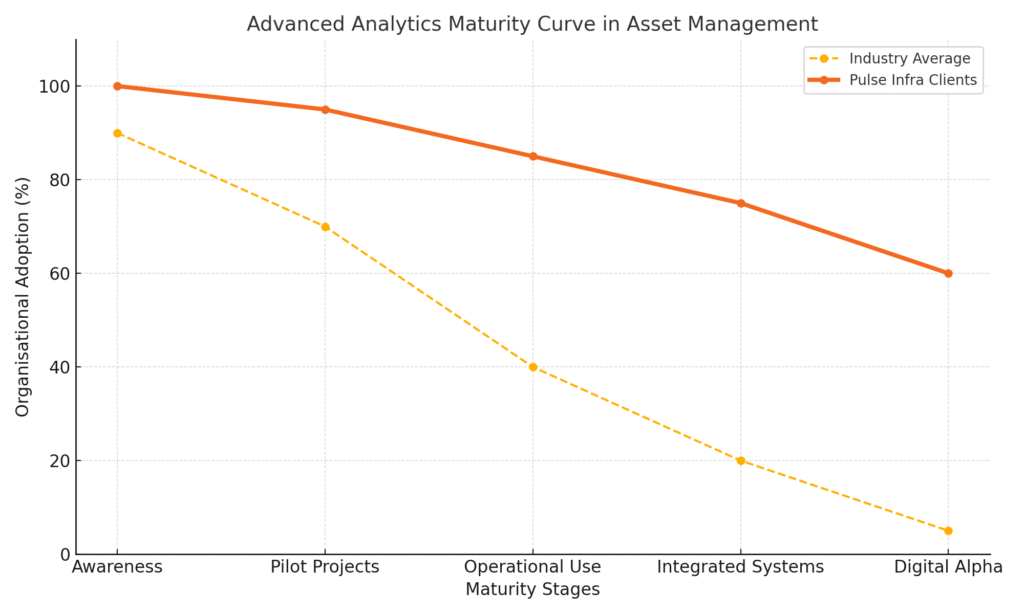A New Approach to Predictive, Risk Based Infrastructure Planning
Executive Summary
Advanced analytics holds transformative potential in asset management—yet many organisations remain stuck in the pilot stage. Despite investments in dashboards and data lakes, few asset-heavy industries have converted data into systemic operational and financial gains. This whitepaper outlines Pulse Infra’s practical delivery methodology for overcoming implementation hurdles and scaling analytics with purpose. It features real-world cases, a maturity curve model, and actionable steps to transition from experimentation to enterprise-scale value creation.
The Analytics Maturity Gap
In today’s digital-first environment, analytics maturity is the differentiator between reactive maintenance and strategic asset stewardship. Many organisations recognise the promise of AI, ML, and predictive tools—but struggle to scale beyond isolated use cases. Common issues include unclear ROI, siloed analytics teams, and lack of alignment between asset managers and data engineers. Pulse Infra specialises in bridging this divide, ensuring data insights flow directly into value-creating operational workflows.

Figure 1: Pulse Infra clients show significantly higher maturity across key analytics adoption stages compared to industry averages.
1. Why Most Analytics Projects Don’t Scale
Based on Pulse Infra’s field experience, the key barriers include:
– Misaligned business and data priorities
– Underinvestment in data governance and quality
– Over-engineered models that fail operational relevance
– Lack of embedded change management or skills uplift
These challenges lead to stalled adoption, scepticism among operations staff, and missed ROI targets.
2. Pulse Infra’s Five-Step Delivery Framework
Pulse Infra moves beyond the theoretical to deliver operational impact through the following five steps:
1. Align on business value drivers and define the right use cases (e.g., failure prediction, lifecycle cost optimisation)
2. Engineer trustworthy data pipelines by unifying condition, event, work order, and asset master data
3. Build and validate algorithms in collaboration with operational experts, not just data scientists
4. Integrate model outputs into workflows—planning, scheduling, reporting—using existing EAM tools
5. Embed analytics literacy and change adoption across maintenance and asset strategy teams
3. Case Snapshots: Analytics in Action
– A Gulf-based transport regulator engaged Pulse to implement predictive maintenance across tunnel and metro systems. This reduced unexpected breakdowns by 27% within a year and enabled real-time reallocation of maintenance budgets.
– In Southeast Asia, a utility client integrated Pulse’s failure probability model into their asset risk register, enhancing CAPEX investment accuracy and reducing risk exposure on ageing assets by 33%.
– A European airport operator used Pulse’s analytics engine to track asset degradation trends, resulting in 15% OPEX savings through dynamic work planning and spares inventory optimisation.
4. Building Scalable and Sustainable Analytics Capability
Sustainable analytics success depends on:
– Executive sponsorship with aligned KPIs
– Governance models for continuous model improvement
– Cross-functional working teams with ownership from both analytics and operations
– A clear roadmap for scaling from use case pilots to enterprise integration
Global Perspectives on Analytics in Asset Management
“Analytics succeeds when the problem is owned by operations and enabled by data—not the other way around.”
– Dr. Markus Stierli, Head of Digital Transformation, Global Utilities Alliance
“Predictive analytics is no longer a technology choice—it’s a strategic imperative for resilient, efficient infrastructure.”
– Rania Al-Farsi, Chief Asset Officer, National Infrastructure Holdings
Conclusion: From Concept to Continuous Value
For asset-intensive organisations, analytics must move beyond dashboards and buzzwords. The Pulse Infra methodology ensures advanced analytics is embedded, operational, and measurable. From identifying value to sustaining impact, Pulse helps clients institutionalise analytics for long-term advantage.
